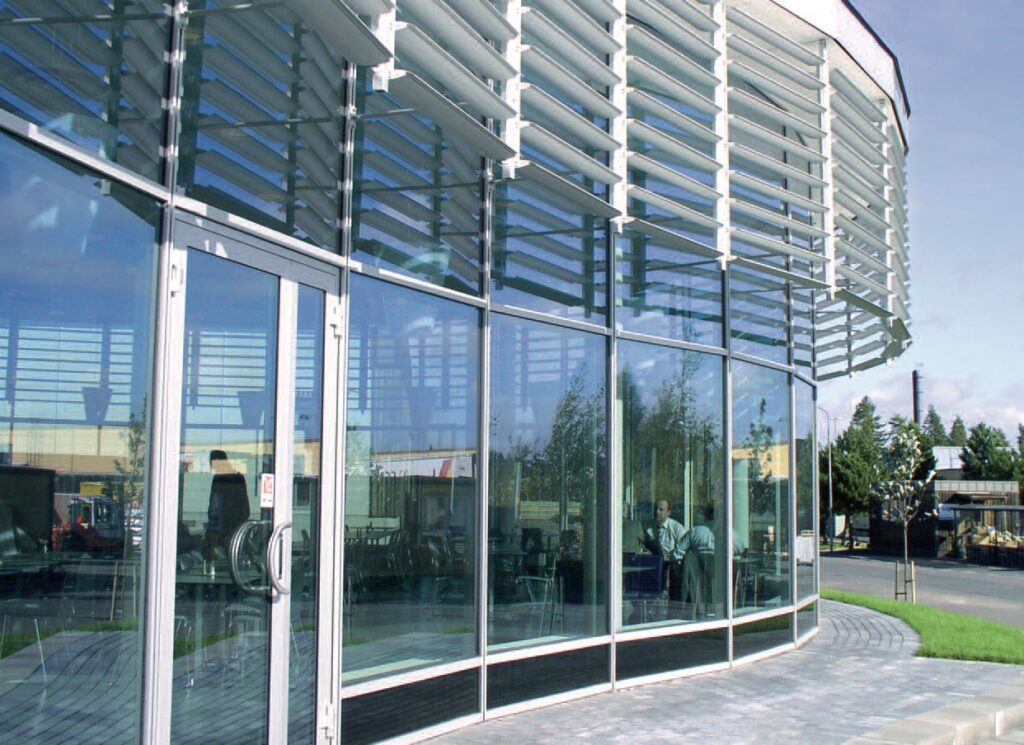Hazlemere Commercial are not just independent aluminium fenestration designers, manufacturers and installers, but they also supply and fit solar control systems.
One of the systems they use is the Elegance SC Solar Control system from Sapa, which has been developed to compliment Sapa’s Elegance curtain walling system (which Hazlemere fabricates and installs). Sapa’s Elegance SC Solar Control System has been designed to meet the ever increasing energy demands put on the building façade. The large expanse of glass achieved by curtain walling creates a greater surface through which the suns rays can enter into the building. To prevent the building from overheating, high performance glasses can be used to reduce the transmission of radiation, however to achieve a comfortable internal temperature, cooling systems are generally employed. On average, the monetary operational cost of mechanically cooling a building is three times more expensive than mechanically heating.
According to its designers Sapa Building Systems Ltd, the introduction of the Elegance SC Solar Control system can significantly reduce the amount of solar radiation on the building façade and therefore reduce the amount of solar gain inside the building. The lower internal temperature reduces the necessity for mechanical cooling, thus cutting energy usage and operational costs. As a passive solar control solution with minimal maintenance, the Elegance SC system provides financial savings year upon year, whilst creating a more carbon efficient building. Correctly positioned, the Elegance SC Solar Control system can provide additional comfort to the building user by reducing solar glare from high solar altitudes during summer months, and by maximizing the solar gains in the winter months to increase internal building temperatures from the low solar altitudes.
There are different types of shading available and these include Horizontal Projecting Shading, which is when a series of blades project directly out from the façade. This configuration works best on South, South-East or South-West facing elevations, although there can be some benefit on other orientations, dependent on the projection. Generally a greater projection blocks more radiation, although for a South facing elevation, there is very little additional benefit by increasing the projection more than 0.8 times the window height. For windows that are tall and narrow, increasing the width of the shading beyond the jambs of the window is more effective than increasing the projection of the shading. For other elevations they are less effective unless a large projection is used.
Horizontal Parallel Shading is where a series of horizontal blades are mounted above one another and connect directly to vertical façade. This configuration is the most effective at blocking radiation, although the amount of transmittance will depend on the angle and the set-out of the blades, as well as the amount of reflectance afforded by the colour. It can also block out a lot of day light too. For South-West and South-East elevations, a blade angle of 0° will block out most of the incoming solar gain, whilst allowing for some view out too. On other elevations the blades will require a greater degree of tilt in order to block out solar gains.
Vertical Parallel Shading is where vertical blades project out either side of a window, or connected directly to the transoms on a vertical façade. For window applications, the blades should extend well beyond the top of the frame for the best results. This configuration is most effective on the
North elevation where the blades can block out most of the sunlight, but it also makes a useful contribution on the North-East and North-West.
To find out how solar shading assists existing commercial premises or those still at the design stage, contact the experienced experts at Hazlemere Commercial for a no obligation consultation.

